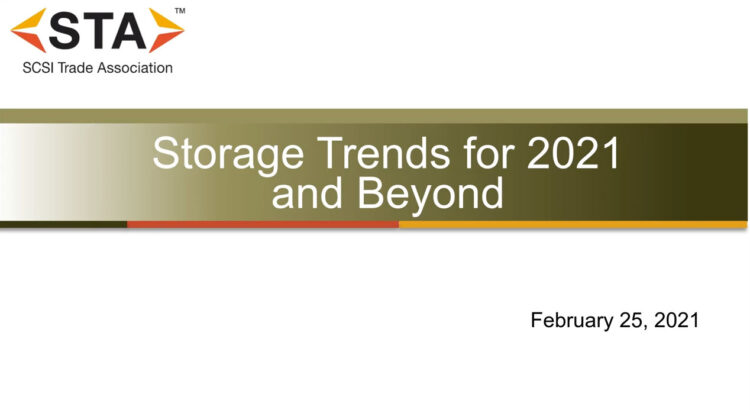Questions from “Storage Trends for 2021 and Beyond” Webcast Answered
This is part two of the Q&A portion of the roundtable talk between Rick Kutcipal, board director, SCSI Trade Association (STA); Jeff Janukowicz, Research vice president at IDC; and Chris Preimesberger, former editor-in-chief of eWeek, where they discussed prominent data storage technologies shaping the market. If you missed this webcast titled “Storage Trends for 2021 and Beyond,” it’s available on demand here.
Part One of the Q&A can be found at https://www.scsita.org/library/qa-part-1-from-storage-trends-for-2021-and-beyond-webcast/.
Q1. What are your views around NVMe over Fabrics?
A1. NVMe technology enables the benefits of flash-based storage to be realized at a much larger scale and not limited to the confines of PCIe backplane-based systems. With NVMe-oF technology, it’s possible to attach many SSDs in a network — generally far more than the number that can be accommodated via PCIe backplane-based systems. With NVMe-oF technology, high performance, low latency flash-based storage resources can be disaggregated from the servers and pooled into a network-attached, shared resource. With this pooling, the ability to provision just the right amount of storage for each workload on each server within the data center is achievable.
This highly resembles SAN technology that SAS/SCSI has been implementing for decades. SAS inherently scales from direct-attach topologies to large-scale storage systems with hundreds (if not thousands) of drives.
Q2. Where can we get the 24G SAS specs?
A2. The T10 Technical Committee of the InterNational Committee for Information Technology Standards (INCITS) develops the technical standards concerning the SAS specifications. INCITS is accredited by, and operates under rules that are approved by, the American National Standards Institute (ANSI). These rules are designed to ensure that voluntary standards are developed by the consensus of industry groups.
Please visit the T10 Working Drafts site for the most comprehensive list of documents for the SAS technical specifications. Anyone can access the drafts until they are published by ANSI, after which they are available for purchase from the ANSI eStandards Store at https://webstore.ansi.org/SDO/INCITS.
Q3. Do you see any effort going into optical SAS? Will it get any coverage at the next plugfest?
A3. Optical 24G SAS cable samples are available today and have been tested during the 24G SAS plugfest. We are seeing an increased interest in active 24G SAS cables, both optical and copper, and expect the trend to continue.
Q4. Do you have any report or study about Intel DC Persistent Memory usage for the next 5 years?
A4. Per the Emerging Non-Volatile Memory report, Market and Technology Report 2020 (Yole Developpement, www.yole.fr):
- The stand-alone emerging NVM market is dynamic and is expected to grow with a CAGR (2019-2025) of ~42%, reaching more than $4B by 2025. 3D XPoint-based products for the datacenter space will play a key role in sustaining this growth.
- The stand-alone STT-MRAM market will be driven by adoption in low-latency storage (e.g., SSD caching), while RRAM could experience a resurgence thanks to the introduction of new low-latency RRAM-based drives by Japanese players.
Q5. Do you see NVMe/TCP becoming the dominant NVMe-oF protocol?
A5. Yes, NVMe-oF using TCP will likely become the preferred highly scalable NVMe protocol as it matures. Today, while NVMe-oF using TCP is not yet fully mature, recent demonstrations have shown comparable throughput, compared to RDMA-based protocols, but there is a need for more efficient processing implementations.
Q6. Why has there been such a delay in getting NVMe Hardware RAID controllers out into the mainstream market? I finally see some tri-mode (SAS/SATA/NVMe) controllers becoming available – do you see these being widely adopted in the server market?
A6. Implementation of hardware RAID is difficult and requires a very intricate interaction between the HW RAID engine and the storage protocol. Today’s RAID engines have been developed and hardened over many generations of products and to introduce a new storage protocol will take time. Innovations to align with the requirements of NVMe hardware RAID will begin to emerge in the near future.
Q7. What do you see as the crossover timeline for NVMe replacing SATA SSDs?
A7. NVMe has already replaced SATA in PC and mobile compute systems. In the enterprise, value SAS is replacing a lot of SATA SSDs due to its near price parity with SATA.
Q8.1 Can you please share with us the roadmap of 24G SAS Disk Drives?
A8.1 The next generation of 24G SAS drives are available now and should become mainstream in 2022. It is expected that the next generation of SAS technology will include improvements made to the drives and to 24G SAS infrastructure, rather than turning the speed crank to 48G SAS.
Q8.2 Can you please share with us the current status of 24G SAS RAID controllers, JBOD Expanders?
A8.2 With a second 24G SAS Plugfest to be concluded in Q4’2021, the SAS ecosystem will reach a major milestone for production readiness. The specification is done, and most major system integrators are investing in it today. 24G SAS RAID/HBA controllers and adapter cards, SSDs, and analyzer products have already been announced, with PCIe 4.0 based servers deploying 24G SAS solutions shipping now. Further product introductions are expected to continue into 2022. Going forward, 24G SAS storage systems are expected within a few quarters after server launches.
Q8.3 In terms of the SAS spec, can you please list the major changes to 24G SAS from 12Gb/s SAS?
A8.3 In addition to doubling the effective bandwidth from 12Gb/s SAS, 24G SAS improvements over 12Gb/s SAS include:
- 20-bit Forward Error Correction (FEC)
- 128b/130b encoding
- Active PHY Transmitter Adjustment (APTA)
- Fairness and persistent connection enhancements
- Storage intelligence to optimize SSD performance
Q9. The IDC slide does not show much SATA SSDs at all…SATA SSDs share was quite prevalent 2015-2020. Agree?
A9. The IDC slide shows enterprise storage capacity shipped, and while SAS and SATA represent a large portion of the storage shipped in 2015-2020, the vast majority of that capacity was in SAS and SATA HDDs, not SSDs.
